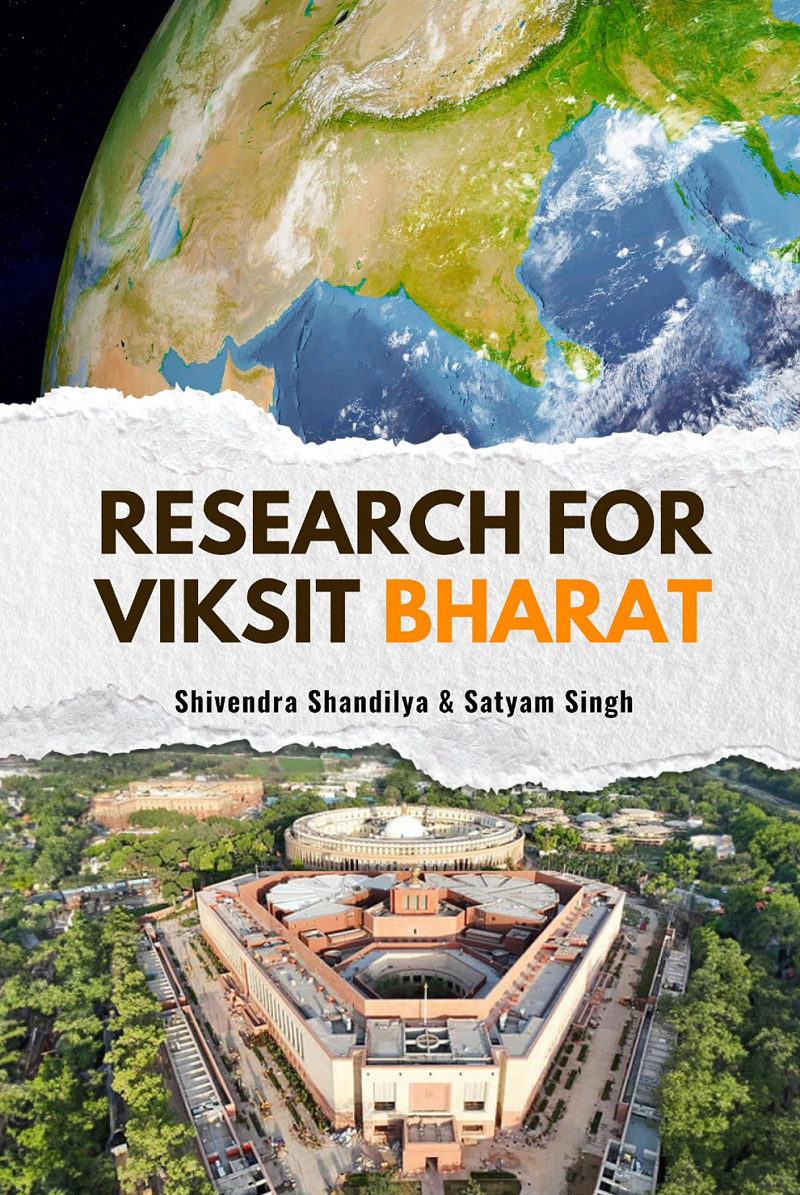Research for Viksit Bharat by Shivendra Shandilya and Satyam Singh presents a forward-thinking vision for India’s transformation into a developed nation by 2047, marking the centennial of its independence. The book explores the intersection of history, innovation, policy, and global trends to chart a comprehensive development roadmap. Drawing inspiration from Prime Minister Narendra Modi’s “Amrit Kaal” concept, the authors provide a detailed blueprint for achieving economic prosperity, sustainability and social equity, making this work both relevant and insightful for policymakers, scholars, and citizens alike.
The book opens with a compelling preface that sets the tone for its ambitious scope. The authors highlight India’s aspirations to become a global leader by fostering inclusivity, resilience, and technological advancement. They underline the importance of collaboration across societal sectors and envision a future rooted in innovation and sustainability. The preface effectively connects India’s historical milestones with its present challenges and future opportunities, emphasizing the transformative potential of research and development (R&D).
The book is organized into ten well-defined chapters, each addressing a critical aspect of India’s development. The structure is both logical and thematic, making it accessible to diverse audiences, including academics, policymakers, and students. The first chapter introduces the concept of “Viksit Bharat,” as envisioned by the Indian government, outlining ambitious goals such as achieving a $30 trillion economy and a per capita income of $18,000 by 2047. The authors emphasize pivotal initiatives like “Jan Bhagidari” (People’s Participation) and “Sabka Saath, Sabka Vikas, Sabka Prayas” in mobilizing collective efforts. Additionally, the chapter discusses global leadership in manufacturing, digital transformation, and renewable energy, setting a visionary framework for the rest of the book.
The second chapter delves into India’s rich intellectual heritage, highlighting ancient contributions to mathematics, astronomy, medicine, and governance. It discusses significant figures such as Aryabhata and Sushruta, as well as institutions like Nalanda and Takshashila. The authors also analyze the impact of British rule on India’s research and development (R&D) during the colonial and post-independence eras, alongside the subsequent nationalist push to reclaim scientific and technological leadership.
In the third chapter, the authors identify priority sectors for national growth, including green technology, biotechnology, advanced manufacturing, and semiconductors. They emphasize the importance of transitioning to Industry 5.0, which integrates human-centric design with cutting-edge technology. Transformative initiatives like the National Green Hydrogen Mission and the India Semiconductor Mission are highlighted as key to achieving sustainable growth and technological self-reliance.
The fourth chapter discusses agriculture, a cornerstone of India’s economy, examining innovations in biotechnology, precision farming, and climate-resilient crops. The authors advocate for sustainable practices to tackle food security and environmental challenges, emphasizing that research and development play a crucial role in these efforts.
The focus of the fifth chapter shifts to human capital, with the authors stressing the importance of education and skill development. They highlight programs such as Skill India and the National Apprenticeship Promotion Scheme as essential for equipping India’s youth with skills for the future. The chapter also discusses how technology can transform education through digital tools and platforms.
In the sixth chapter, public-private partnerships (PPPs) are presented as a critical mechanism for fostering innovation and infrastructure development. The authors discuss successful PPP initiatives in digital infrastructure, renewable energy, and advanced manufacturing, showcasing how these partnerships can reduce the financial burden on the public sector while driving technological progress.
The seventh chapter focuses on India’s advancements toward self-reliance in defense, highlighting indigenous projects like the Tejas fighter aircraft and missile systems such as Agni and BrahMos. The authors emphasize the importance of fostering innovation in defense technologies to strengthen national security and enhance global competitiveness.
The eighth chapter explores India’s partnerships with international R&D organizations, discussing collaborative projects in areas such as space exploration, renewable energy, and biotechnology. The authors advocate for enhanced participation in global value chains and strategic alliances to amplify India’s influence on the world stage.
The penultimate chapter examines the challenges to cultivating a robust research culture in India, including funding limitations, regional disparities, and infrastructure deficits. The authors propose solutions such as incentivizing R&D investments, fostering academia-industry linkages, and addressing the digital divide to create an equitable and innovation-driven ecosystem. The concluding chapter consolidates the vision of a self-reliant and prosperous India, reiterating the importance of resilience, innovation, and inclusivity in achieving the nation’s developmental aspirations.
The book effectively bridges India’s historical legacy with its future aspirations, providing a holistic perspective on national development. The inclusion of tables, figures, and case studies enhances the book’s credibility and practical relevance. By addressing a wide range of sectors, from agriculture to defense, the authors ensure the coverage is both broad and detailed. The book situates India’s development within the larger global narrative, highlighting international collaborations and geopolitical considerations.
While economic and technological aspects are explored in depth, issues like gender equality and marginalized communities receive limited attention. The book occasionally sidelines the contributions of grassroots movements and the private sector. While the strategies are ambitious, the authors do not always provide detailed plans for addressing implementation challenges, especially in underdeveloped regions.
Research for Viksit Bharat is a seminal work that outlines an ambitious yet achievable vision for India’s future. By combining historical insights with forward-thinking strategies, the authors provide a roadmap for sustainable and inclusive growth. While the book has minor limitations, its strengths far outweigh them, making it an essential read for policymakers, researchers, and anyone invested in India’s development journey.
This book is highly recommended for individuals seeking to understand India’s developmental trajectory and the policy frameworks driving it. It serves as both a guide and a source of inspiration, emphasizing the collective effort required to realize the dream of a Viksit Bharat.
The book is published by Evincepub Publishing in 2024 and is Available on Amazon & Flipkart.
(Author is Research Scholar in the Department of National Security Studies at Central University of Jammu. Feedback at: [email protected])








